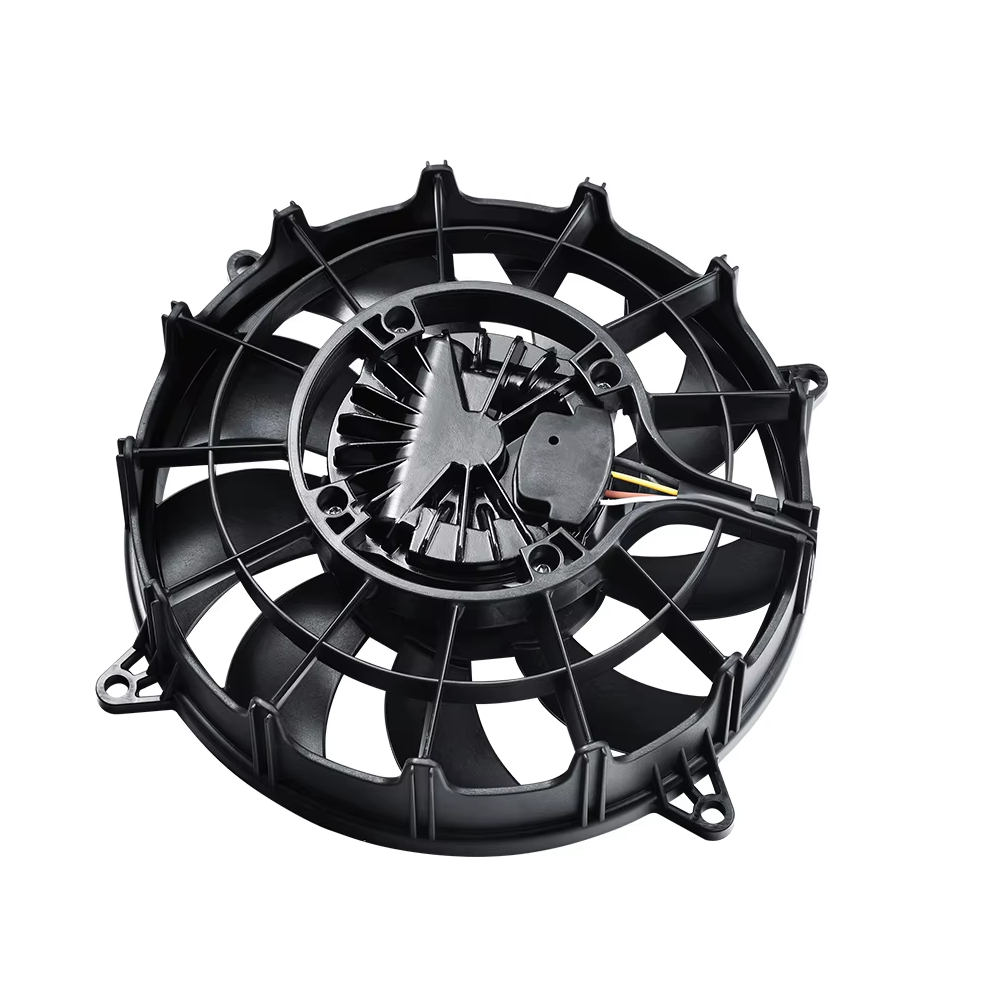Forget generic specs. Choosing between axial fans and centrifugal blowers (often just called “blowers”) impacts system efficiency, noise, cost, and longevity. We’ve dissected 40 technical parameters using real 2024 test data (AMCA 210, ISO 5801, ISO 13347) and field experience to give you an actionable comparison. No fluff, just critical insights.
Core Physics & Design: Why They Behave Differently
-
Airflow Path:
-
Axial: Air enters & exits parallel to the motor shaft (like a propeller). Straight-line flow.
-
Blower: Air enters axially, gets flung 90 degrees by impellers, exits perpendicularly (like a squirrel cage). Direction change requires energy.
-
-
Pressure Generation:
-
Axial: Creates pressure via axial momentum. Excellent for low static pressure (< 150 Pa typically). Efficiency plummets rapidly as pressure rises.
-
Blower: Creates pressure via centrifugal force. Built for medium to very high static pressure (100 Pa – 2500+ Pa). Holds efficiency better under load.
-
-
Housing Impact:
-
Axial: Minimal housing (frame + guard). Performance highly sensitive to inlet/outlet obstructions.
-
Blower: Scroll-shaped volute casing is integral. Converts kinetic energy to pressure efficiently, tolerates proximity effects better.
-
-
Motor Drive:
-
Axial: >90% use direct-drive motors (especially BLDC/EC). Lower mechanical loss, compact.
-
Blower: Common use of belts/pulleys >5kW for speed control. Direct-drive EC increasing. Higher starting torque often needed.
-
Performance Under the Microscope: Flow, Pressure, Efficiency
-
Peak Airflow (CFM): Axial Wins. At zero pressure, axial moves 30-50% more air per frame size (e.g., 120mm: Axial ~220 CFM vs Blower ~150 CFM).
-
Peak Static Pressure: Blower Wins. By design, blowers dominate (e.g., 120mm: Axial ~75 Pa vs Blower ~250 Pa; Industrial: Axial <150 Pa vs Blower >2500 Pa).
-
Pressure Curve Shape:
-
Axial: Steep drop after peak pressure point. Vulnerable to “stall” if overloaded.
-
Blower: Gradual decline. More stable operation across pressure range.
-
-
Efficiency at Free Air (0 Pa): Axial Wins. Direct-drive BLDC axial can hit 82-88% efficiency (CFM/Watt).
-
Efficiency at 100 Pa: Blower Wins. Axial struggles (~40-50% eff), Blower shines (~65-75% eff).
-
Turndown Ratio (EC/BLDC): Axial Wins. Modern EC axial fans maintain efficiency down to ~5% speed (20:1 ratio). EC blowers typically 10:1.
-
System Effect Tolerance: Blower Wins. Blowers handle duct bends, filters, and resistance far better due to inherent pressure capability.
Energy, Noise & Lifetime: Operational Realities
-
Power at Max Flow (0 Pa): Axial Wins. Significantly lower (e.g., 120mm: Axial 14W vs Blower 38W).
-
Power at 100 Pa: Blower Wins. Vastly more efficient under load (e.g., Axial 40W+ vs Blower 22W).
-
Startup Current: Axial Wins. Typically 1.5x run current. Blower: 3-8x run current (impeller inertia).
-
Noise at Free Air: Axial Wins. Quieter moving same CFM (e.g., 35-45 dB(A) vs 50-60 dB(A) @1m).
-
Noise at 100 Pa: Blower Wins. Axial becomes loud & turbulent (>65 dB(A)), Blower remains controlled (48-55 dB(A)).
-
Noise Character:
-
Axial: Broadband “whoosh.” Annoying when overloaded.
-
Blower: Tonal “whoosh” + potential blade-pass “whine.” Can be subjectively irritating.
-
-
Vibration Levels: Axial Wins (Generally). Lower rotating mass (direct drive) often means lower vibration (0.8-1.5 mm/s RMS vs 1.2-2.0 mm/s RMS).
-
Bearing Life (EC/BLDC): Comparable. Quality EC units (axial or blower) achieve 60,000-80,000 hours MTBF. Belt-driven blowers need more maintenance.
-
IP Rating Range: Blower Wins (Typically). Scroll housing facilitates higher standard IP ratings (IP55-IP66 common). Sealed axial available (IP68) but costlier.
System Integration & Application Fit: Getting it Installed Right
-
Ducting Requirement: Blower Wins. Essential for ducted systems, filters, or any resistance. Axial: Only suitable for very short/straight ducts or free air.
-
Space Constraints (Flow Path): Blower Wins. Perpendicular inlet/outlet offers layout flexibility. Axial needs clear straight runs (5x dia min).
-
Mounting Flexibility: Blower Wins. Less sensitive to inlet proximity. Axial: Critical inlet clearance required.
-
Filter Loading Tolerance: Blower Wins. Designed to handle increasing pressure as filters clog. Axial performance collapses.
-
Variable Load Stability: Blower Wins. Gradual pressure curve handles load changes better. Axial can stall suddenly.
-
Shock/Vibration Resistance: Blower Wins (Generally). Robust housing and often heavier construction. Sensitive axial blades can deflect.
-
Material Handling (Dirty Air): Blower Wins. Scroll housing better contains particulates. Open axial propellers vulnerable.
-
Cost per Unit CFM (Low P): Axial Wins. More economical for high-flow, low-pressure tasks.
-
Cost per Unit Pressure: Blower Wins. More economical when pressure > ~75 Pa is needed.
-
Footprint (CFM/cm³): Axial Wins. Higher flow density in the flow direction.
Critical Selection Tables: Putting Data to Work
Table 1: Performance Profile – Standard 120mm Frame (EC/BLDC Motors)
| Parameter | Axial Fan | Centrifugal Blower | Who Wins? | Why It Matters |
|---|---|---|---|---|
| Max Airflow @ 0 Pa | ~220 CFM | ~150 CFM | Axial | Ventilation, high-volume cooling |
| Max Static Pressure | ~75 Pa | ~250 Pa | Blower | Ducting, filters, resistance |
| Eff. @ Max Flow (0 Pa) | ~18 CFM/W | ~4 CFM/W | Axial | Energy cost in free air apps |
| Eff. @ 100 Pa | ~5 CFM/W | ~7 CFM/W | Blower | Energy cost under load |
| Noise @ Max Flow (0 Pa) | ~40 dB(A) | ~55 dB(A) | Axial | Office, lab, quiet equipment |
| Noise @ 100 Pa | >>65 dB(A) (Loud!) | ~50 dB(A) | Blower | Noise-critical under-pressure apps |
| Typical IP Rating | IP44 (Open) / IP68 (Sealed) | IP55-IP66 | Blower (Standard) | Harsh/dusty environments |
Table 2: Industrial Units (1.5-2.2kW Range) – Key Differentiators
| Parameter | Industrial Axial | Industrial Centrifugal | Key Takeaway |
|---|---|---|---|
| Realistic Max Flow | 6,000 – 12,000 CFM | 4,000 – 8,000 CFM | Axial for sheer volume |
| Realistic Max Pressure | 100 – 150 Pa | 800 – 2500+ Pa | Blower for overcoming resistance |
| Peak Efficiency | 82-88% (near 0 Pa) | 75-83% (at ~50% max P) | Match duty point! |
| Turndown Stability | Good (EC) | Very Good (EC) | Blower handles partial load well |
| Duct System Suitability | Poor (Short runs only) | Excellent | Blowers are for ductwork |
| Lifetime Cost (High P App) | High (Inefficient) | Lower | Wrong fan = high energy bills |
Practical Scenarios: When to Lock in Your Choice
-
Axial Fan = Mandatory: Server room cooling (high flow, low P), condenser coil airflow, warehouse ventilation, spot cooling machinery (unobstructed), exhaust where duct resistance is minimal (< 30 Pa).
-
Centrifugal Blower = Mandatory: Furnace air handlers, fume extraction (through ducts/filters), powder conveying, air knives/drying, medical device airflow (pressurized chambers), ERV/HRV units, any system with >1m duct or a single filter.
-
Grey Zone (75-150 Pa): Careful analysis needed. EC axial might work if oversized and noise isn’t critical. EC Blower is usually the robust choice. Test both!
Professional Q&A: Addressing Common Dilemmas
-
Q: Can I use multiple small axial fans instead of one large blower for pressure?
-
A: Rarely effective. While parallel fans increase flow, they do not significantly increase the pressure capability of the system. The system pressure is determined by the resistance, and each fan still struggles against that same pressure. Blowers are fundamentally designed for pressure.
-
-
Q: How critical is fan curve data from the manufacturer?
-
A: Absolutely essential. Never select based solely on max CFM or max Pressure. You MUST know the performance (CFM, Pressure, Efficiency, Noise) at YOUR system’s specific operating point (the “duty point”). Generic data leads to poor system performance.
-
-
Q: EC (Electronically Commutated) vs. AC: Which is better for blowers?
-
A: EC (BLDC) is superior in almost all aspects for both fan types where available: Higher efficiency (especially at partial load), precise speed control, lower starting current, quieter operation, and longer life. The higher initial cost is offset by energy savings (ROI often <2 years). AC is simpler/cheaper upfront for fixed-speed, high-duty applications.
-
-
Q: We need variable airflow. Is speed control (VFD/EC) enough, or do we need different fans?
-
A: Speed control is powerful BUT has limits. An axial fan slowed down to hit a pressure target becomes very inefficient. A blower handles variable speed across its range much better. First, choose the right fan TYPE (axial vs blower) for your system’s maximum pressure requirement. THEN use speed control to modulate flow efficiently within that fan’s capable range.
-
-
Q: What’s the biggest mistake you see in fan selection?
-
A: Two tied for first: 1) Ignoring Static Pressure: Assuming “CFM is CFM” without calculating system resistance. 2) Using Axial Where Blower is Needed: Trying to force an axial fan to overcome high resistance results in excessive noise, energy waste, low airflow, and premature failure. Know your system pressure!
-
Ready to optimize your system? Understanding these 40 points is the foundation. Always consult performance curves for your specific application’s static pressure and airflow requirements. Using the wrong fan type is the costliest mistake you can make.



